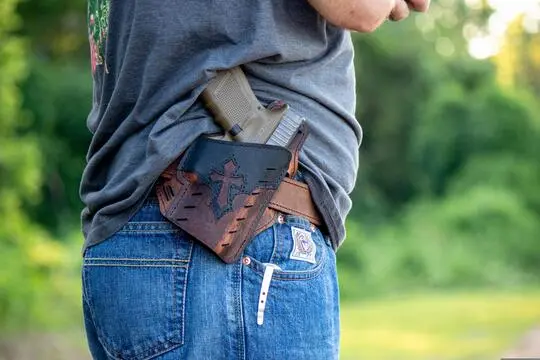When it comes to firearms, choosing the right gun sight is crucial. Whether you're using a handgun or a long gun, having the right sight can greatly enhance your shooting accuracy. In this article, we will explore the various types of gun sights available, their functionalities, and the pros and cons of each option. By the end, you'll have a better understanding of the different sight options and be able to make an informed decision based on your needs.
Handgun Sights
Fixed Sights
Fixed sights are the most basic type of handgun sights. They consist of a front post and a rear notch that are fixed in place. These sights do not offer any adjustment options and are typically found on budget-friendly handguns. While fixed sights are reliable and easy to use, they may not be as accurate as other options due to their lack of adjustability.
Adjustable Sights
Adjustable sights, as the name suggests, allow for windage and elevation adjustments. These sights have a rear sight that can be moved horizontally and vertically to fine-tune your aim. Adjustable sights are commonly found on target pistols and offer greater precision and accuracy compared to fixed sights. However, they may be more complex to use and require periodic adjustment.
Tritium Sights
Tritium sights, also known as night sights, are designed to enhance visibility in low-light conditions. These sights contain small vials of tritium gas that emit a glow without requiring an external light source. Tritium sights are highly durable and provide excellent visibility in the dark. However, they are typically more expensive than other sight options.
Visit the Tru-Glo store for Tritium Sights
Fiber Optic Sights
Fiber optic sights utilize a small rod of light-gathering material to enhance visibility. These sights are particularly effective in bright lighting conditions. The fiber optic rod gathers ambient light and directs it towards the shooter's eye, creating a bright and highly visible sight picture. Fiber optic sights are popular among competitive shooters and are also available in combination with tritium for increased versatility.
Visit the Tru-Glo store for Fiber-Optic Sights
Reflex Sights (Red Dot Sights)
Reflex sights, commonly known as red dot sights, are popular among both handgun and long gun users. These sights project a red dot or reticle onto a glass lens, allowing for quick and accurate target acquisition. Reflex sights are parallax-free, meaning the dot remains on target regardless of eye position. They are also highly durable and offer unlimited eye relief. However, reflex sights may be bulkier and more expensive than other handgun sight options.
Laser Sights
Laser sights utilize a laser beam to indicate the point of impact on the target. These sights can be either grip-activated or pressure pad-activated. Laser sights are particularly useful in low-light situations and can be highly effective for rapid target acquisition. However, they may require batteries and are not as precise as other sight options.
Long Gun Sights
Open Sights
Open sights, also known as iron sights, are the most common type of sight found on long guns. They consist of a front post and a rear notch, similar to fixed handgun sights. Open sights are simple, reliable, and do not require any batteries. However, they may be less precise than other sight options, especially at longer distances.
Aperture (Peep) Sights
Aperture sights, also referred to as peep sights, have a small circular aperture as the rear sight. These sights offer improved accuracy compared to open sights as they help align the shooter's eye with the front sight. Aperture sights are commonly found on rifles and are popular among hunters and target shooters. They are more precise than open sights but may take some time to get used to.
Scopes (Telescopic Sights)
Scopes, also known as telescopic sights, are optical devices that provide magnification and improved target acquisition. These sights consist of a tube with lenses that magnify the target image. Scopes are highly versatile and offer various magnification levels to suit different shooting needs. They provide excellent accuracy and are commonly used for precision shooting and hunting. However, scopes can be bulkier and more expensive than other sight options.
Prismatic Sights
Prismatic sights combine the benefits of scopes and red dot sights. These sights use a prism to project a reticle onto the shooter's eye, similar to a red dot sight. Prismatic sights offer magnification, allowing for better target identification, and are also compact and lightweight. They are a popular choice for tactical rifles and provide a good balance between speed and precision.
Reflex Sights (Red Dot Sights)
As mentioned earlier, reflex sights are also a popular choice for long guns. The same benefits of quick target acquisition and unlimited eye relief apply to long gun reflex sights as well. They are commonly used in competitive shooting, tactical applications, and hunting.
Holographic Sights
Holographic sights use a laser to project a holographic reticle onto a glass display. These sights offer a large and clear sight picture, allowing for quick and precise target acquisition. Holographic sights are highly durable and can withstand extreme conditions. However, they tend to be more expensive than other sight options.
Laser Sights
Similar to handgun laser sights, long gun laser sights project a laser beam onto the target. They are particularly useful for low-light situations and can greatly enhance accuracy. However, laser sights may require batteries and are not as precise as other sight options.
Night Vision Sights
Night vision sights utilize technology that allows shooters to see in complete darkness. These sights are commonly used by law enforcement and military personnel. Night vision sights can be highly effective for night hunting as well. However, they are typically expensive and require additional equipment.
Thermal Sights
Thermal sights detect heat signatures and can be used to identify targets in complete darkness or through fog and smoke. These sights are commonly used by law enforcement and military personnel for surveillance and target acquisition. Thermal sights are highly advanced and provide a significant advantage in low-visibility conditions. However, they are typically very expensive and may not be necessary for most civilian applications.
Choosing the Right Gun Sight
When selecting a gun sight, several factors should be considered. First, consider the purpose of your firearm. Are you using it for self-defense, target shooting, or hunting? The shooting environment is also crucial. Will you be shooting in bright daylight or low-light conditions? Finally, consider your personal preferences and shooting style. Each sight option has its own advantages and disadvantages, so it's important to choose one that suits your needs and preferences.
Comparing Different Gun Sight Options
To help you make an informed decision, let's compare the different gun sight options side by side. The table below provides a summary of the features and benefits of each sight type:
| Sight Type | Description | Pros | Cons |
|---|---|---|---|
| Fixed Sights | Basic, non-adjustable sights | Simple and reliable | Lacks adjustability |
| Adjustable Sights | Sights with windage and elevation adjustments | Greater precision and accuracy | Requires periodic adjustment |
| Tritium Sights | Night sights that glow in the dark | Enhanced visibility in low-light conditions | Relatively expensive |
| Fiber Optic Sights | Sights that gather ambient light for visibility | Bright and highly visible sight picture | Less effective in low-light conditions |
| Reflex Sights | Red dot sights that project a dot onto a lens | Quick and accurate target acquisition | Bulkier and more expensive than other options |
| Laser Sights | Sights that utilize a laser beam | Effective for rapid target acquisition in low-light situations | Not as precise as other sight options |
| Open Sights | Basic sights found on long guns | Simple and reliable | Less precise, especially at longer distances |
| Aperture (Peep) Sights | Sights with a small circular aperture | Improved accuracy compared to open sights | May require some adjustment and getting used to |
| Scopes | Magnifying sights with various levels of zoom | Excellent accuracy and target acquisition | Bulkier and more expensive than other sight options |
| Prismatic Sights | Compact sights that offer magnification | Good balance between speed and precision | Not as versatile as scopes |
| Reflex Sights | Red dot sights also suitable for long guns | Quick target acquisition and unlimited eye relief | Commonly used, may lack uniqueness |
| Holographic Sights | Sights that project a holographic reticle | Large and clear sight picture | More expensive than other sight options |
| Laser Sights | Laser beam sights for long guns | Enhanced accuracy in low-light situations | Not as precise as other sight options |
| Night Vision Sights | Sights that provide night vision capabilities | Ability to see in complete darkness and low-visibility conditions | Expensive and require additional equipment |
| Thermal Sights | Sights that detect heat signatures | Effective in low-visibility conditions | Very expensive and may not be necessary for most applications |
Conclusion
In conclusion, choosing the right gun sight is essential for maximizing your shooting accuracy. Handgun sights such as fixed sights, adjustable sights, tritium sights, fiber optic sights, reflex sights, and laser sights offer a range of options to suit different needs and preferences. Long gun sights including open sights, aperture sights, scopes, prismatic sights, reflex sights, holographic sights, laser sights, night vision sights, and thermal sights provide even more versatility and specialized functionalities.
When selecting a gun sight, consider factors such as the purpose of your firearm, the shooting environment, and your personal preferences. By understanding the different types of gun sights and their pros and cons, you can make an informed decision and find the right sight for your needs. Explore the options available and embrace the world of gun sights to enhance your shooting experience.




